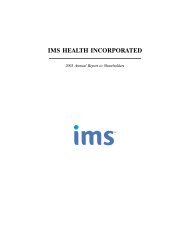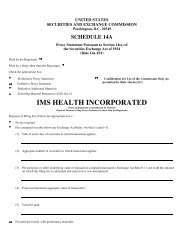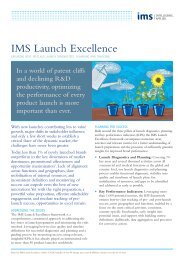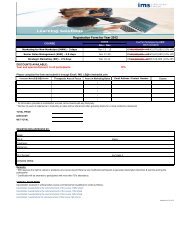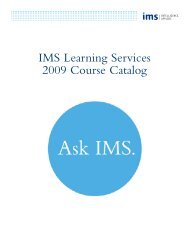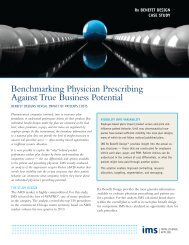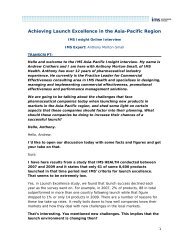Transcript - IMS Health
Transcript - IMS Health
Transcript - IMS Health
Create successful ePaper yourself
Turn your PDF publications into a flip-book with our unique Google optimized e-Paper software.
The pharmaceutical<br />
industry is very<br />
conservative and best<br />
described as slow<br />
followers so they don’t<br />
adapt to change very<br />
quickly.<br />
<strong>Transcript</strong><br />
Modernizing Incentive Compensation Plans<br />
Thought Leader: Stephen M. Fox, Global Practice Leader, Sales Performance Center<br />
of Excellence, <strong>IMS</strong> Management Consulting<br />
Recording Date: 3/16/2010<br />
In this episode, I meet with Stephen Fox, Global Practice Leader, Sales Performance<br />
Center of Excellence at <strong>IMS</strong> Management Consulting. We talk about incentive<br />
compensation plans in the pharmaceutical industry – why the incumbent plans<br />
aren’t working and how new solutions have emerged that improved the accuracy<br />
and efficiency of plans. Stephen was featured in the January 2010 issue of<br />
PharmaVOICE in an article on incentive compensation plans.<br />
I’m Dan Limbach, your host and producer of the PharmaVOICE Webcast Network.<br />
Dan: Welcome to the podcast program, Steve.<br />
Stephen: It’s great being with you today, Dan.<br />
Dan: Steve, you’ve worked on all three sides of the pharmaceutical industry,<br />
including pharmaceutical companies, consultants, and vendors. What’s your unique<br />
perspective on incentive compensation?<br />
Stephen: Well, that’s a very interesting question because people who work within<br />
the pharmaceutical companies really only see their own incentive compensation<br />
plans and they don’t have insights into how other companies operate. From<br />
interacting with a large number of companies, I have found that since most<br />
companies use the same consulting firm to advise them on their IC plan design,<br />
most companies – though not all of them, I mean some are innovators out there –<br />
but most companies tend to have similar or identical IC plans and what’s even more<br />
surprising is that some of these IC plan design concepts are about 10 years out of<br />
date.<br />
Dan: Well, that sounds like cause for concern. Why do you think their IC plans are<br />
so antiquated and can you give us some examples?<br />
1
The incentive plan was<br />
based on total sales<br />
volume, so there was a<br />
complete disconnect<br />
between the marketing<br />
strategy and the sales<br />
incentives.<br />
<strong>Transcript</strong> (continued)<br />
Modernizing Incentive Compensation Plans<br />
Stephen: Well, in my opinion, the pharmaceutical industry is very conservative and<br />
best described as slow followers so they don’t adapt to change very quickly.<br />
Companies tend to continue to use the same approaches they’ve used for many<br />
years, especially when they are under the misconception that the consulting firms<br />
they’re using are supposed to be the experts. Let me give an example.<br />
The marketing strategy for one company’s product was to initiate therapy on 10 mg<br />
of the drug and if that didn’t control the disease, then the patient should be titrated<br />
to 20 mg. However, the incentive plan was based on total sales volume, so there<br />
was a complete disconnect between the marketing strategy and the sales<br />
incentives. A better approach would have been to design the IC plan so that the<br />
representatives were incentivized on the percentage of new to brand prescriptions<br />
that went to the company’s 10 mg dosage, and then to have a second incentive<br />
based on the percent of patients on 10 mg, that were switched to 20 mg versus a<br />
switch to a competitor product. That way, the representatives would have been<br />
incentivized exactly inline with the sales and marketing strategy, rather than merely<br />
on total sales volume for the product.<br />
Dan: Well, these sound like some new and innovative ideas for incentive<br />
compensation. I’d like to go a little deeper. Can you explain what’s behind this<br />
shift?<br />
Stephen: Absolutely. I think there are three things that are driving this. First of all,<br />
there are new data sources that give us access to measures and metrics that were<br />
previously unavailable. I actually presented at the PMSA last year in 2009 on<br />
Innovative Uses of Patient Level Data for Incentive Compensation. This new data<br />
source is opening up a whole range of new approaches for incentive compensation.<br />
Let me give an example.<br />
A company found that for one of their products, if patients received three<br />
prescription refills, then there was an 80% chance that the patient will be on the<br />
drug for 12 months. So instead of setting quotas based on total sales or total script<br />
volume, we use patient level data to design an incentive program based on the<br />
percentage of patients on initial therapy that then went on to receive three refills.<br />
This approach aligned the tactical implementation with corporate strategy.<br />
2
The second industry phenomena<br />
that is changing incentive plans<br />
are the new commercial models<br />
that are being rolled out across<br />
industry.<br />
<strong>Transcript</strong> (continued)<br />
Modernizing Incentive Compensation Plans<br />
Now this type of incentive plan would never been done previously with NRx or TRx<br />
data, but it’s now possible using the new patient level data sources.<br />
The second industry phenomena that is changing incentive plans are the new<br />
commercial models that are being rolled out across industry. This is creating new<br />
job functions, new roles and responsibilities and new client interactions. As a<br />
result, we now need incentive programs to motivate and reward these people in<br />
these new positions. It can’t be the same old sales based volume approach.<br />
Companies are defining new key performance indicators and this is driving the<br />
creation of new performance metrics. And with new data sets and new<br />
performance metrics, we can no longer use the same old software to manage our<br />
incentive programs.<br />
So the third change that’s happening is that companies are starting to reevaluate<br />
their incentive compensation software and they’re replacing their old IC applications<br />
with next generation applications, but we can talk about that in more detail later on.<br />
Dan: Certainly, but I’ll make sure we come back to the software issue. Can you<br />
describe additional ways that incentive compensation plans can be improved?<br />
Stephen: Yes, let me give you a few more examples. One company asked us to<br />
evaluate why high performing territories were high performing and why low<br />
performing territories were low performing. From our analysis, it became very<br />
apparent that high performing territories tended to be in geographies that were less<br />
controlled by managed-care companies and low-performing territories tended to be<br />
more disadvantaged by managed care restrictions. The company who wasn’t taking<br />
managed care influence into consideration when they were setting their sales<br />
objectives. So territories with equal sales and equal potential got the same sales<br />
quota, irrespective of the managed care access. So, when setting quotas, it’s<br />
important to factor in the influence of managed care, but few companies actually do<br />
that.<br />
3
It may seem logical that<br />
territories with equal sales<br />
and equal potential get the<br />
same sales quota, but if a<br />
territory is trending up, then<br />
it will easily exceed quota<br />
while if another territory is<br />
trending down, it will never<br />
reach quota.<br />
<strong>Transcript</strong> (continued)<br />
Modernizing Incentive Compensation Plans<br />
Recently, a company was evaluating their IC plan design and when we looked at<br />
their design, we found that territories that had high sales growth were over<br />
performing while territories with low sales trends were under performing and the<br />
reason was that their plan design was based on historic sales and didn’t take into<br />
consideration the sales trend. It may seem logical that territories with equal sales<br />
and equal potential get the same sales quota, but if a territory is trending up, then it<br />
will easily exceed quota while if another territory is trending down, it will never<br />
reach quota.<br />
As a result, the company is now investigating using trend-based quota methodology.<br />
Now, this approach is more complicated because it involves creating statistical<br />
trending models for each individual territory, which requires new statistical<br />
software, new skills, and much more time to develop plans and it leads us to the age<br />
old question: do you want simple IC plans or do you want IC plans that are fairer?<br />
Another example is a problem that many companies are facing. How do you create<br />
incentive programs for products that have multiple indications or have on-label and<br />
off-label usage? Using patient level data, one client was able to distinguish<br />
between on-label and off-label prescribing because if the product was prescribed<br />
concomitantly with the drug from a specific therapy class, this would indicate the<br />
drug was being used on-label. If it was prescribed as monotherapy or co-<br />
prescribed with different therapeutic products, then it’s off-label use. This helped<br />
them to quantify on-label and off-label usage so they can now design incentive<br />
plans that only reward representatives for on-label product usage.<br />
Another approach to this type of analysis involves the use of medical claims data. A<br />
profile or persona can be created that defines patients where the product’s usage is<br />
for the one specific disease or diagnosis rather than alternative diagnosis. This<br />
persona is then overlaid onto the patient level data and each patient in the database<br />
is assigned a percentage probability if the product prescribed matches the required<br />
diagnosis, then a cut off of maybe 75 or 80 percent probability is used to aggregate<br />
the data assigned to the required diagnosis. This can then be used to create<br />
differential incentive plans for products with multiple indications. Now these kinds<br />
of examples can only be done using the newly available patient level data.<br />
4
The strategic advantage<br />
comes from the<br />
functionality available and<br />
how the company uses a<br />
software.<br />
<strong>Transcript</strong> (continued)<br />
Modernizing Incentive Compensation Plans<br />
Dan: I love the real world examples. Steve, earlier in our talk, you mentioned<br />
incentive compensation software. What can you tell us about developments in this<br />
area?<br />
Stephen: First of all, let’s start by asking a couple of rhetorical questions. If you<br />
wanted a spreadsheet application or an email package or word processing<br />
program, would you ask a consulting firm to custom develop that for you? Well, of<br />
course not. You’d buy it from Microsoft, which is a software company and what<br />
about an EOP application, would you custom develop that? Well, again the answer<br />
is no, you’d buy a CP.<br />
So why should incentive compensation software be any different? Maintaining<br />
customs software, whether you do it internally within your own organization or<br />
whether you get a consulting firm to do it for you, doesn’t give a pharmaceutical<br />
company any strategic advantage, which is why companies are implementing<br />
enterprise applications, such as SAP, Documentum for document management,<br />
Lombardi for business process management, and business intelligent tools by<br />
Cognos and Business Objects. The strategic advantage comes from the<br />
functionality available and how the company uses a software.<br />
Even if the consulting firm can bring an army of offshore resources to custom code<br />
an incentive compensation application, it’s still inefficient in the long run. A<br />
software company that provides an enterprise application will continue to bring<br />
enhancements and new modules that upgrade and extend the IC functionality. If a<br />
company uses a custom application, then they have to conceive and design all that<br />
new functionality themselves, which takes months of effort and they also have to<br />
pay for the extra software development and maintenance. They’re also locked into<br />
that one consulting firm and they no longer have the opportunity to become vendor<br />
independent.<br />
One of the best practices for outsourcing and the reason why companies deploy<br />
enterprise applications rather than vendor-developed custom software is to ensure<br />
that the ongoing administration of the application is vendor independent and they<br />
can then move to other outsourcing companies either for financial or performance<br />
reasons. As a result, some companies are now replacing their custom in-house<br />
5
It took us a lot of time and<br />
money and people to<br />
maintain the application<br />
and to reprogram each time<br />
the IC plans change or the<br />
sales force structure<br />
change.<br />
<strong>Transcript</strong> (continued)<br />
incentive compensation applications or their consultant-developed incentive<br />
compensation applications by an enterprise incentive application.<br />
Now, I’ve personally gone through this twice myself. I worked at one company that<br />
maintained its own internal IC application. This was very resource incentive. It took<br />
us a lot of time and money and people to maintain the application and to reprogram<br />
each time the IC plans change or the sales force structure change. So we brought<br />
in a consulting firm to deploy their customer application, but that didn’t really help<br />
us much because their solution didn’t have all the functionality we needed and it<br />
still took of an army of people to maintain it.<br />
So the company then switched to an enterprise application and that delivered all the<br />
functionality that we required with about one-third of the previous support stuff. We<br />
also had guaranteed upgrade pathways for future enhancements and new modules,<br />
which were developed and deployed directly by the software company and then<br />
made available to all the clients.<br />
Dan: That sounds good. What are some other benefits to an enterprise solution?<br />
Stephen: Enterprise IC applications are much easier to maintain. The IC plans are<br />
considered rather than programs. Gartner published an article suggesting that<br />
there’s somewhere between 3 percent and 8 percent overpayment of bonuses,<br />
which can be mitigated by deploying an enterprise incentive comp application.<br />
Dan: Microsoft Office is relatively inexpensive. Can’t companies just use Excel to<br />
track sales and calculate commissions?<br />
Modernizing Incentive Compensation Plans<br />
Stephen: Price Waterhouse Coopers reported that 90 percent of all financial<br />
spreadsheets have errors, yet many smaller pharma companies still use Excel to<br />
manage their IC plans. We worked on a project to document the business<br />
processes for a pharma company that was using 11 integrated spreadsheets to<br />
manage their IC plans. When we looked at their spreadsheets, we found formulaic<br />
errors resulting in overpayments of about 10 percent of the bonus payments.<br />
6
The other trend on<br />
technology side is the<br />
movement to software to<br />
service or on-demand<br />
applications.<br />
<strong>Transcript</strong> (continued)<br />
Modernizing Incentive Compensation Plans<br />
Another pharma company with an in-house developed IC application using very<br />
complex incentive comp business rules and very complicated software structures<br />
were unable to forecast their future bonus payments. At the end of the year, they<br />
found they were 20 percent over budget, which was very embarrassing because<br />
they didn’t know that until they calculated their bonus payments, which didn’t<br />
happen until March the following year. So can you imagine the conversation in<br />
March between the VP of sales operations going back to the president of the<br />
company saying hey, remember my sales force bonus budget from last year? Well,<br />
we’re now three months since the following year and we’ve just found out we’re 20<br />
percent over budget for last year.<br />
Dan: So what’s keeping companies from switching and doing it the right way,<br />
especially if it’s cost effective?<br />
Stephen: Unfortunately, people don’t want to own up to those types of errors, which<br />
makes it more difficult to cost justify deployment of new software.<br />
Dan: So given these challenges, where do you see the market heading?<br />
Stephen: The other trend on technology side is the movement to software to<br />
service or on-demand applications. Again, there’s no strategic advantages to<br />
pharmaceutical company buying then installing and maintaining hardware or<br />
licensing software, implementing it, managing all the version control, doing backup<br />
and restore, database tuning, disaster recovery, all of the other administrative tasks<br />
it takes to support an IC application. So companies are moving to purchase on<br />
demand where the entire application is delivered as a service. That is, the software,<br />
hardware, infrastructure, together with all the ongoing IT support, maintenance and<br />
version upgrades are all provided by the software company on a per user fee basis.<br />
The two classic examples of this kind are Salesforce.com, which are providing sales<br />
force automation software as a service, and Callidus, which is providing incentive<br />
compensation software on demand.<br />
Dan: Well thanks for all those outstanding examples, that’s great stuff. So how<br />
would you summarize the changes that are occurring in the incentive compensation<br />
arena within the pharmaceutical industry?<br />
7
In summary, incentive<br />
compensation is really<br />
becoming much more<br />
efficient and more effective.<br />
<strong>Transcript</strong> (continued)<br />
Modernizing Incentive Compensation Plans<br />
Stephen: I think companies are starting to recognize that there are ways of<br />
improving their legacy, incentive compensation plan designs to reduce bias and to<br />
make plans fairer. New data sources are driving sales, marketing, and sales<br />
operations people to reevaluate the measures and metrics they use for incentive<br />
compensation. So their incentive programs are better aligned with their product<br />
strategy.<br />
The deployment of new commercial models is creating a whole new set of<br />
incentive compensation objectives, and companies are turning to on-demand<br />
enterprise incentive compensation software to accommodate all these changes<br />
and to enable deployment faster and cheaper than consult and build applications<br />
with the added benefit of eliminating a lot of non-strategic IT activities.<br />
In summary, incentive compensation is really becoming much more efficient and<br />
more effective.<br />
Dan: Well that sounds like great news for everyone involved. Steve, I’d like to<br />
thank you for sharing your thought leadership and expertise with us today.<br />
Stephen: It’s been a pleasure talking with you.<br />
And that does it for this episode. For more information on incentive compensation<br />
plans, visit www.<strong>IMS</strong><strong>Health</strong>.com, and don’t forget to check out our other podcasts<br />
at PharmaVOICE.com/podcasts.<br />
Until next time, I’m Dan Limbach.<br />
8
About This Company<br />
Modernizing Incentive Compensation Plans<br />
Operating in more than 100 countries, <strong>IMS</strong> <strong>Health</strong> is the worldís leading provider of<br />
market intelligence to the pharmaceutical and healthcare industries. With $2.2<br />
billion in 2009 revenue and more than 50 years of industry experience, <strong>IMS</strong> offers<br />
leading-edge market intelligence products and services that are integral to clientsí<br />
day-to-day operations, including product and portfolio management capabilities;<br />
commercial effectiveness innovations; managed care and consumer health<br />
offerings; and consulting and services solutions that improve productivity and the<br />
delivery of quality healthcare worldwide. Additional information is available at<br />
http://www.imshealth.com.<br />
9




